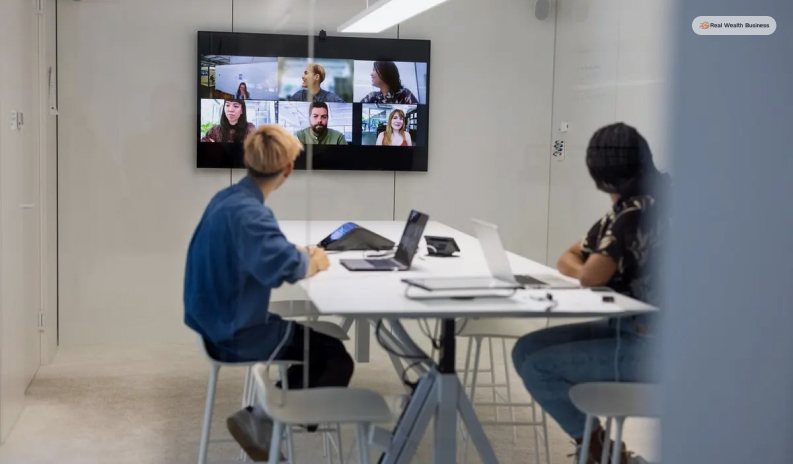What Is The Hybrid Working Model? How To Implement It In The Most Successful Ways
by Abdul Aziz Mondal Job & Career 28 August 2023

For several businesses, hybrid working is the new way to work, while others are still figuring out its benefits. Adopted by various tech giants, the hybrid form of working holds large potential to blend company objectives with flexible work arrangements. However, there are certain challenges to this adoption.
Today, in this comprehensive guide, I will be laying out what is hybrid work, its benefits as well as the challenges faced. If the hybrid work model is something that piques your interest, this article is all you need! So, keep reading it till the end.
Definition Of The Hybrid Working Model

Digital changes in workplace communication as well as collaboration, are reducing the need for physical presence in the workplace. With increasing acquaintance with telecommunication and cloud-based systems, a number of firms are willing to empower their workforce with autonomy. There can be a switch between operating remotely and in the office.
A number of global industries are mandating less work-from-office days. Here, the employees have to operate off-site for certain days, which can be preferred by them. Essentially, this model can capitalize on the most advanced systems. Hybrid working offers the flexibility that the workforce demands while still acquiring the benefits of a brick-and-mortar office.
Ways To Implement This Model

The challenge of implementing this model depends extensively on the present infrastructure of the firm. In several cases, it seeks a period of adjustment. However, if you are keen on developing a solid hybrid model for your workplace, here are 5 steps to follow…
- A Central Cloud-Based System
A significant aspect of implementing the hybrid working model is to ensure easy and unbiased access to resources for all employees. The goal remains on enhancing communication, and collaboration as well as carrying out operations effectively, irrespective of their operational location. This is why it is important to adopt a cloud-based model for file sharing.
The key aspects that deserve attention are access limitations for remote employees, security issues, and compatibility issues. Companies having adequate budgets can opt for tools like Microsoft Office 365, which offers an overall solution. Firstly, it offers a secure, comprehensive, and fully integrated service, followed by handling spreadsheets and managing tasks efficiently.
- Switch To A Remote-First Work Approach
Just like a centralized cloud system, workplaces must also learn to adapt to a remote-first work approach. Remote working remains the default in all processes, be it project management or communications. Offering equal and easy access to data for both off-site and on-site workers has become simpler.
This might seek changes within the company’s system and might require a transformation in the employee mindset. Each country has a different culture which is why the emphasis should be put on communication in office life. A lot of people are still using the traditional way of working.
A remote-first approach offers a record for almost everything, and small questions can be asked within a recognized channel. Meetings can become more accessible for remote workers as all decisions and updates can be easily documented.
- Hybrid Working Collaboration
Implementing a remote-first approach as well as a cloud-based system lays down the foundations of this model. In order to know what is hybrid work truly, collaboration will remain a major factor. Such a step depends completely on employees owning the precise hardware for assisting online collaboration.
Efficient communication channels continue to play a key role, like team structure in allocating projects, as well as team leaders. Keep in mind to opt for high-quality digital conferencing monitors that have an in-built microphone and FHD webcam. Such equipment helps an employee join virtual meetings without losing any energy.
Types Of Remote Work Models

There are some popular types of hybrid work models that any workplace can implement. Check out some of the most common ones here:
- Remote-First Model
A number of leaders are opting for “remote-first,” indicating that their functions closely monitor the activities of a fully remote industry. Needless to say, maximum offices will allow other employees to function from the office as well. The range of flexibility can differ from one employee to another, owing to their designation and work tenure.
Remote-first hybrid working looks a bit different for each employee, although the key principle is that all companies must act like that of a fully remote one. This approach is indicative that the workforce can work away, but those who wish to work on-site are always welcome.
- Office-Occasional Model
Certain firms are willing to switch back to the office because they don’t want employees to lose productivity. Such brands might construct a hybrid model that might be discussed as office-occasional. Employees will have the liberty to visit the office a few days a week.
Based on the needs of the company, this might be a loose policy. The core of this hybrid working model is that brands are not going entirely remote-first like previously. Rather, they opt for keeping the office intact along with some functional employees. Since they will occasionally come, the workforce will be local, not distributed.
- Office-First But Remote-Allowed Model
The third but most important alternative is to keep both the hybrid work and office ongoing, but offices remain the primary working place. Before the COVID-19 pandemic, this model was the most common setup. Moreover, the approach remains typically common when the leadership team remains in the office.
In the office-first hybrid model, the industry provides a remote functional policy. Further, it can have certain employees scattered and cataloged under different sequences. A different way for such a setup is whether the bulk of the workforce operates from the workplace, including the team leaders. Such a combination might not be good for productivity and employee engagement.
Advantages Of The Hybrid Working Model

Adopting hybrid working models might be effective only when you are well aware of its benefits. Significantly, this model also enhances employee satisfaction rates. Let me quickly take you to the perks of adopting the remote working model.
Takes Productivity To Another Level
It doesn’t matter whether your teammates write code, solve customer queries on call, or try to conduct some team meeting. In every process, their time is the most valuable thing. A lot of employees out there feel more productive when they work remotely. Others might like working on-site.
Recently, people have learned how to adjust to this new reality. From working remotely, even if they never did it before, to homeschooling kids during lockdown- the new normal is becoming a part of life. In a recent survey, almost 66% of people favored working from home when it comes to boosting their productivity.
Boosts Job Satisfaction
Just like the nature of work, job satisfaction has also undergone a transformation in the post-pandemic era. While 53% of job seekers say that they are happy with their jobs, a relative 47% do not feel satisfied with the way they have been operating. Hence, there is still left to be done when it comes to enhancing job satisfaction.
Employees operating in a hybrid working model are comparatively more satisfied than those who are working exclusively on-site. Such high satisfaction levels experienced by employees can attribute to their sense of freedom of working. This might have a positive impact on productivity.
Maintains Work-Life Balance

Operating full-time on-site can be a bit distressing- although it was up until the pandemic came along. But at present, employees want peace of mind while they work for the organization. As per research by the Economic Times, nine out of ten professionals prefer hybrid work over the conventional working model.
They said they can easily create a work-life balance when they have the freedom to work as per their will. Right after they complete their login hours, they can dedicate their time to their hobbies- without commuting to a faraway place. The hybrid model is efficient for striking an efficient work-life balance.
Decreases Operating Costs
Well, the advantages of the remote model are not limited to employees only. With less workforce in the office, there will not be the need for a large space. Hence, the cost of real estate comes down significantly. Additionally, the company will no longer need to spend tons of cash on providing office supplies.
When it comes to the hybrid working model, small business owners can save operating charges and invest money somewhere else. They might cut down the cost of transportation and commute, which will again follow the same path- saving money!
It Improves Mental Health
The fact that the pandemic has a deep impact on our mental health is not undeniable. Health concerns, financial uncertainty as well as isolation- all contribute to affecting the mental wellness of people worldwide. However, with the hybrid work culture, this can be significantly improved.
Firstly, an employee gets the opportunity to work both on-site and off-site. This indicates that he can get acquainted with his colleagues in the right amount. Additionally, they can work remotely on other days and bring out their actual productive side- it’s a win-win situation.
Hybrid Working: What Are The 4 Key Challenges Faced?

The benefits of hybrid operating are many, and so are its challenges. Today, leaders have to propose an overall new strategy that can meet their demands of making employees work- whether on-site or off-site. Let’s figure out the challenges of the remote work model:
Connectedness And Culture
It might be a bit complex to stay connected with your team and colleagues when you are operating remotely. In this transforming landscape, work is always constant. Each employee has a dependency on the other – hence, the need for communication keeps developing. Here, you might have to be a bit creative with communication.
Look out for virtual ways to stay connected with one another. You might want to hold virtual happy hours or off-work meetings. This ensures you have a personal connection with your teammates even if you cannot be physically present at the workplace.
Tampered Productivity

Consistent studies have found that employees following hybrid working are logged in for 10 hours or more but with a reduced productivity level. When asked about it, they said they find it a bit difficult to keep up a productive routine. Apart from having the perfect structure for your business, different business teams should be allowed to make environments that fit them right.
Future enterprises might be able to operate as a “coherently distributed workforce,” delivering outcomes with a relatively small team on board. Not all the teams in the company can accommodate a business-wide policy on the remote working days vs. the ones at the office.
Autonomy And Balance
The blurred boundary between operating from the office and home might also bear negative impacts on employees. Further, it results in boosted work stress and anxiety. It might also make it a bit difficult for workers to take time off and perform their personal jobs- owing to the need to always be available.
A clever tip here will be to establish clear boundaries between home as well as work. Both the leadership team and HR must ensure that practical employee programs are conducted and implemented across the company.
Motivation

It is due to team activities that employees are connected to organizational priorities and objectives. A lot of teams feel disconnected from common goals and shared purpose when they operate in a hybrid working framework. Thus, it impacts both productivity and engagement at the same time.
Various factors might contribute to accomplished team performance. For starters, teams must have a clear sense of direction and purpose. Also, they should know what they are working for and what is its importance. After developing these factors in mind, a team can build motivation among themselves- whether working from the office or home.
Final Words
The new “hybrid working” framework seems inevitable, which is why organizations must include the right set of collaborative tools. Both on-site and remote employees should get the opportunity of working effectively, irrespective of the work setting.
So, that was all about the different aspects of remote working. I hope this comprehensive guide enlightened you about what difficulties you will face while operating remotely. Also, there are some of its benefits intact.
Don’t forget to share your comments below!
Read Also:



































































































